10 things you didn't know about cannabis grading

By Gregory Frye
Professional cannabis grading is quickly becoming a go-to asset for wholesale buyers and sellers in the legal market.
When a batch of cannabis is graded, a supplier is now empowered with the knowledge necessary to receive a fair market price, and a potential buyer suddenly has hundreds of data points from which they can make informed decisions. It saves on costs and time when you don’t have to hire a sales or procurement team to gather this information, and graded cannabis sees a 90% reduction in returns.
More important, cannabis grading also adds transparency across the supply chain and creates a common language on which the industry can grow. While grading is standard in other industries, it is fairly new to the cannabis world.
Big Tree Grading, recently sat down to reveal some of the big pointers people may not realize about cannabis grading, as well as address some of the popular misconceptions.
1. GRADERS DON’T CONSUME THE CANNABIS
When people think of cannabis grading, one of the biggest misconceptions is that graders score weed after smoking it and then noting the effects.
“That’s not what we do it all,” Graders at Big Tree clarify. “A lot of people think that in order to grade cannabis, you have to smoke it to understand whether it’s quality or not, which isn’t the case.”
Big Tree Grading doesn’t judge effects because different people can experience different effects from the same sample. For example, aspects such as body chemistry, mental state, location, intention, experience, dosage and set and setting can all influence the effects of a single strain from one person to the next. The Big Tree Grading process avoids these types of subjectivity, instead maintaining an objective approach in order to be able to provide consistency and standardized grading.
2. GRADERS UTILIZE THE INTERNATIONAL CANNABIS AND HEMP STANDARDS
Instead of testing the cannabis by consuming it, graders actually score individual lots based on the grading system developed by the International Cannabis and Hemp Standards (ICHS). This includes categories for aroma, smell, structure and color – each with 100 data points.
The ICHS are unique to cannabis. In other industries, like wine or beef, grading has been commonplace for sometime, but with cannabis, the plant was illegal for so long that it’s necessity in functioning underground made it impossible to develop a uniform standard and language. With legalization, that is finally changing.
3. AROMA IS THE FIRST ATTRIBUTE GRADERS ASSESS
Smell will often reveal more than anything else when grading a cannabis sample.
Aroma is a big indicator of quality. It will say a lot about how the material was dried and cured. Granted, some terpene profiles can smell like funky cheese, although that doesn’t mean there’s something wrong. Conversely, if the lot smells like damp hay or a wet basement, you likely have a problem.
4. GRADERS PHYSICALLY HANDLE THE FLOWER
After digging into the aroma, graders will take out a light for an up-close view. Trichomes are obviously one of the biggest things they’re looking at here.
“Does the flower look like it was rolled in sugar, or no? Healthy trichomes are often a sign of potency,” explains Big Tree. They also check density, structure of the bud and look for bright, healthy colors – greens, oranges, purples, etc.
5. GRADERS PAY ATTENTION TO HOW CANNABIS IS TRIMMED
With all the trimming methods out there, the last thing a grower wants is to needlessly drive down the price of their flower because of how it was trimmed.
Does it look like a cannabis flower? Or does it look like somebody tried to shave it with a pair of scissors into looking like a cannabis flower?
“If you try to force the shape of the cannabis flower while you're trimming it, you're going to damage it and it's going to be noticeable. You really want to accentuate the parts of the flower, highlight what the flower looks like rather than trying to form or shape it with your scissors,” says graders at Big Tree.
6. PERFECT SCORES ARE RARE
Out of a total possible cannabis score of 100, products above 95 are rare.
Big Tree Grading CEO, Eric Cozens, extrapolated on the topic, saying, “On a point scale from 1-100, we consider 50 a neutral score. Nothing really positive or negative about the product. On scores below 50 you’ll start seeing defects like molds or oxidized colors. Above that, from 50-70 is where most of the budget flower will land. 70s-90s is the mid to average quality levels, and anything above a 90 is premium top-shelf quality.”
7. SEEING LOTS OF CANNABIS IS PART OF THE JOB
Utilizing the ICHS’ common language and standardizing the initial grading process, Big Tree has increased volumes by 924% from 2017 to 2018. Since then they’ve sustained a 250%+ yearly increase each year since 2018.
With Big Tree having graded over 200,000 pounds since starting in 2016, it’s safe to say seeing lots of cannabis is an integral part of the job.
8. GRADERS CAN EVALUATE CROPS FOR INSURANCE
Crop insurance is an important option for farmers who want to mitigate their risks. It can also be expensive. In the cannabis and hemp sectors, a grader can visit and provide an objective evaluation of the crop’s worth.
This circles right back to transparency, where both sides know the value of the crop.
9. GRADERS REQUIRE TRAINING AND CERTIFICATION
Even if this goes without saying, it’s still worth mentioning. Cannabis graders require special training. They must be well-versed in the ICHS and know how to work with suppliers who are preparing their crops for market.
Cannabis grading essentially strengthens the entire supply chain, so proper training is key for this critical role.
10. GRADING CANNABIS IS A REAL JOB
This happens with a lot of cannabis jobs, and maybe more so with grading, since so many are confused about what cannabis graders do.
Misconceptions about cannabis industry professionals are gradually fading as people realize the cannabis industry is a real industry, with real jobs, and many hard working people. The industry professionals are serious about their job, and they are serious about cannabis. Grading is just one of many respectable paths in the cannabis industry.

Gregory Frye is a storyteller, writer, editor and award-winning journalist with a love for meaningful collaboration. Most recently, he was part of the founding team at Green Flower Media, where he spent almost five years as executive online editor.
